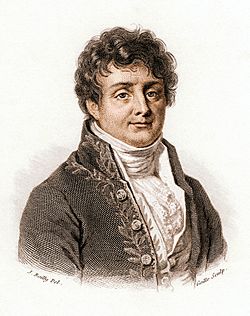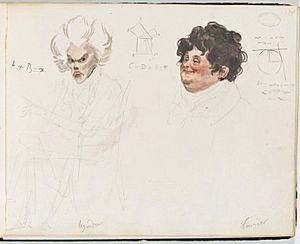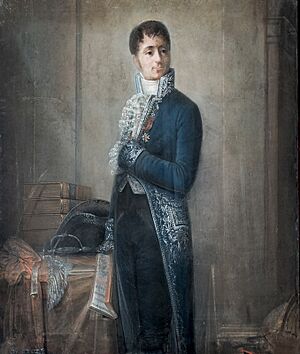Joseph Fourier facts for kids
Quick facts for kids
Joseph Fourier
|
|
|---|---|

Jean-Baptiste Joseph Fourier
|
|
| Born | 21 March 1768 |
| Died | 16 May 1830 (aged 62) |
| Nationality | French |
| Alma mater | École Normale Supérieure |
| Known for | (see list) Fourier number Fourier series Fourier transform Fourier's law of conduction Fourier–Motzkin elimination Greenhouse effect |
| Scientific career | |
| Fields | Mathematician, physicist, historian |
| Institutions | École Normale Supérieure École Polytechnique |
| Academic advisors | Jean-Baptiste Biot Joseph-Louis Lagrange |
| Notable students | Peter Gustav Lejeune Dirichlet Claude-Louis Navier Giovanni Plana |
Joseph Fourier (born March 21, 1768 – died May 16, 1830) was an important French mathematician and physicist. He was born in Auxerre, France. He is famous for his work on Fourier series, which helps us understand how heat moves and how things vibrate.
He also helped create what we now call the Fourier transform and Fourier's law of conduction. Many people also believe he was the first to discover the idea of the greenhouse effect, which explains how Earth's atmosphere keeps our planet warm.
Contents
Joseph Fourier's Early Life and Education
Joseph Fourier was born in Auxerre, France. His father was a tailor. Sadly, he became an orphan when he was only nine years old.
A kind bishop helped him get an education. He studied with the Benedictine Order at the Convent of St. Mark. Even though he couldn't join the army's science group because of his birth, he became a mathematics teacher for the military.
He was involved in the French Revolution in his local area. For a short time, he was even put in prison. But in 1795, he started teaching at the École Normale and later at the École Polytechnique.
Working with Napoleon in Egypt
In 1798, Fourier joined Napoleon Bonaparte on his trip to Egypt. He went as a scientific advisor. He became the secretary of the Institut d'Égypte, a science group Napoleon started in Cairo.
When the British navy cut off France from Egypt, Fourier helped organize workshops. These workshops made sure the French army had the supplies they needed. He also wrote many math papers for the Egyptian Institute. After the French army left Egypt in 1801, Fourier went back to France.

Life as a Governor and Heat Experiments
In 1801, Napoleon made Fourier the Governor (called a Prefect) of the Department of Isère in Grenoble. In this job, he helped build roads and other projects.
While he was in Grenoble, he started his famous experiments on how heat travels. He presented his important paper, On the Propagation of Heat in Solid Bodies, in Paris in 1807. He also helped create a huge book about Egypt called Description de l'Égypte.
In 1822, Fourier became the Permanent Secretary of the French Academy of Sciences. This was a very important position. He never got married. He died in 1830.
Fourier's Legacy and Memorials
Joseph Fourier is buried in the Père Lachaise Cemetery in Paris. His tomb has Egyptian designs to remember his time in Egypt. His name is also one of the 72 names written on the Eiffel Tower.
A statue of him was put up in Auxerre in 1849, but it was melted down during World War II. The Joseph Fourier University in Grenoble is named after him, honoring his contributions.
Understanding Heat: The Analytic Theory of Heat
In 1822, Fourier published his most famous book, Théorie analytique de la chaleur (The Analytical Theory of Heat). In this book, he explained how heat moves. He used Newton's law of cooling, which says that heat flows between two close objects based on how different their temperatures are.
This book had three big ideas. One was a new math idea. Fourier said that almost any kind of function (a math rule that describes how things change) could be broken down into a series of sine waves. This idea, even though it needed more work, was a huge step forward. It led to what we now call the Fourier transform.
Another important idea was about dimensional homogeneity. This means that in any math equation, the units on both sides must match. For example, if one side is about length, the other side must also be about length. Fourier helped us understand this important rule.
His third big idea was his heat equation. This is a special math equation that describes how heat spreads through objects. Students who study mathematical physics still learn this equation today.
Discovering the Greenhouse Effect
In the 1820s, Fourier made an important discovery about Earth's temperature. He calculated that if Earth was only warmed by the Sun, it should be much colder than it actually is. He thought about different reasons for this extra warmth.
He realized that Earth's atmosphere might act like an insulator, trapping heat. This idea is now known as the greenhouse effect. Even though Fourier didn't call it that, his work was the first time this idea was suggested.
Fourier looked at an experiment by de Saussure. De Saussure used a vase with several layers of glass separated by air. Sunlight entered through the glass. He found that the temperature was warmer in the inner parts of the vase. Fourier thought that gases in the atmosphere could work like these glass layers, keeping the Earth warm. This idea helped lead to the name "greenhouse effect."
Works
- Fourier, Jean Baptiste Joseph (1820). "Sur l'usage du théorème de Descartes dans la recherche des limites des racines". Bulletin des Sciences, Par la Société Philomatique de Paris: 156–165. https://archive.org/details/bulletindesscien20soci.
- Fourier, Joseph (1822) (in fr). Théorie analytique de la chaleur. Paris: Firmin Didot Père et Fils. OCLC 2688081. https://archive.org/details/bub_gb_TDQJAAAAIAAJ.
- (in fr) Théorie analitique de la chaleur. 1. Paris: Gauthier-Villars. 1888. https://gutenberg.beic.it/webclient/DeliveryManager?pid=11917672.
- Fourier, J (1824a). "Remarques Générales Sur Les Températures Du Globe Terrestre Et Des Espaces Planétaires". Annales de Chimie et de Physique 27: 136–167. https://books.google.com/books?id=1Jg5AAAAcAAJ&pg=PA136.
- Fourier, Joseph (1824b). Gay-Lussac, Joseph Louis; Arago, François. eds. "Resume theorique des Proprietes de la chaleur rayonette". Annales de Chimie et de Physique (Paris) 27: 236–281. https://books.google.com/books?id=1Jg5AAAAcAAJ&pg=PA236.
- Fourier, Joseph (1827a). Mémoire sur la température du globe terrestre et des espaces planétaires. 7. Mémoires de l'Académie Royale des Sciences. pp. 569–604. http://gallica.bnf.fr/ark:/12148/bpt6k32227.image.r=memoires+de+l%27academie+des+sciences.f808.langEN. Translation by W M Connolley
- Fourier, Joseph (1827b). Mémoire sur la distinction des racines imaginaires, et sur l'application des théorèmes d'analyse algébrique aux équations transcendantes qui dépendant de la théorie de la chaleur. 7. Memoirs of the Royal Academy of Sciences of the Institut de France. pp. 605–624. http://gallica.bnf.fr/ark:/12148/bpt6k32227/f844.image.r=memoires+de+l'academie+des_sciences.langEN.
- Fourier, Joseph (1827c). Analyse des équations déterminées. 10. Firmin Didot frères. pp. 119–146. http://num-scd-ulp.u-strasbg.fr:8080/827/.
- Fourier, Joseph (1827d). Remarques générales sur l'application du principe de l'analyse algébrique aux équations transcendantes. 10. Paris: Memoirs of the Royal Academy of Sciences of the Institut de France. pp. 119–146. http://gallica.bnf.fr/ark:/12148/bpt6k32255.image.r=memoires+de+l%27academie+des_sciences.f346.langEN.
- Fourier, Joseph (1833). Mémoire d'analyse sur le mouvement de la chaleur dans les fluides. 12. Paris: Memoirs of the Royal Academy of Sciences of the Institut de France. pp. 507–530. http://gallica.bnf.fr/ark:/12148/bpt6k3227s.image.r=memoires+de+l%27academie+des_sciences.f620.langEN.
- Fourier, Joseph (1821). Rapport sur les tontines. 5. Paris: Memoirs of the Royal Academy of Sciences of the Institut de France. pp. 26–43. http://gallica.bnf.fr/ark:/12148/bpt6k3220m.image.f568.pagination.langEN.
Images for kids
See also
 In Spanish: Joseph Fourier para niños
In Spanish: Joseph Fourier para niños
- Fourier analysis
- Fourier–Deligne transform
- Heat equation
- Least-squares spectral analysis
- List of things named after Joseph Fourier





